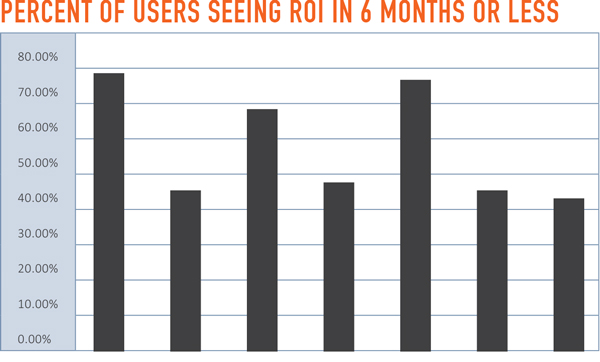BlueArrow Telematics, provider of mobile workforce technologies, recently employed a research assistant to analyze dozens of telematics reports, surveys, and statistics to gain greater insight into how and why fleets use telematics systems. After analyzing the data, one of the more interesting facts about telematics usage in the fleet industry is that budget is the biggest barrier to telematics adoption for most fleets.
The issue lies in the fact that operating a fleet is rarely considered as a part of the revenue generating side of the business—especially in industries where the fleet vehicle is simply a tool to get a technician and his equipment to and from his next job. Instead, many executives prefer to manage their fleet as cheaply as they can and ultimately fail to consider the significant ROI that an investment in telematics can bring to their operations.
The issue gets exponentially more difficult on the government side, as the fleet managers for cities and counties must get large expenses approved by a never-ending chain of bureaucrats and politicians more concerned with their next election than approving more “expenses” for fleets. Many of these fleet managers are hesitant, or unable to adopt, due to budget constraints.
Today fleets can no longer afford not to adopt telematics. Reducing risk associated with unsafe driving behaviors, improving mobile workforce efficiencies, and reducing unnecessary vehicle maintenance costs are coming to the forefront of business. One major accident for an organization can be detrimental both in cost and by tarnishing the company’s reputation.
PROVIDER VS PARTNER
Effectively using telematics technologies provides management with clear, concise data to help avoid costly accidents, inefficiencies, and vehicle repairs that lead to downtime.
But be carefuL. Choosing a low-cost telematics provider may backfire on you as telematics systems continue to advance. Choose a telematics provider with integration and expandability capabilities. It is also wise to avoid long-term contracts when purchasing a telematics system. If you decide to switch providers before your contract is up, termination fees will likely make that “free equipment deal” much more expensive than if you purchase equipment outright without contracts. The old saying, “You pay by time, money, or frustration,” certainly applies to making a bad decision by choosing a telematics solution with “free” equipment offers.
The difference between a telematics provider and a telematics partner is the key to a successful telematics strategy. It’s important to find a provider that understands your line of work and listens to your needs and concerns to help provide a telematics solution that best suits your business in the most affordable and efficient way. Custom reporting and consultation should be included as part of your subscription. Don’t choose a provider that nickels and dimes you for this support.

Chart shows the percentage of the customer base for seven major telematics providers that realized ROI within six months. Each bar represents the average of a provider’s customers.
GROWING NEED
Here’s an analogy that may provide some perspective on how critical telematics will become to the fleet industry. Imagine a world 25 years ago without cell phones. Now that the telecommunications industry has dramatically evolved with an explosion in technological advancement, 98% of people today say cell phones have a positive impact on their lives. Many of us would be lost without them. While that’s interesting, it isn’t quite wholly relevant to the fleet industry. What’s interesting is the fact that 96% of a leading provider’s customers said that telematics has had a positive impact on their fleet.
Integrating a telematics system into your fleet increases efficiency through real-time communication, improves safety through driver monitoring, reduces operating costs associated with idling, and enhances security among many other benefits. The list of possibilities with a telematics system goes on and on. There’s a reason telematics systems have integrated into fleets all over the nation so rapidly—and those fleet managers are onto something.
FOR MORE INFORMATION
Find out more about telematics systems, visit www.bluearrowtelematics.com.
_______________________________________________
MODERN WORKTRUCK SOLUTIONS:
JANUARY 2020 ISSUE
Did you enjoy this article?
Subscribe to the FREE Digital Edition of Modern WorkTruck Solutions magazine.




